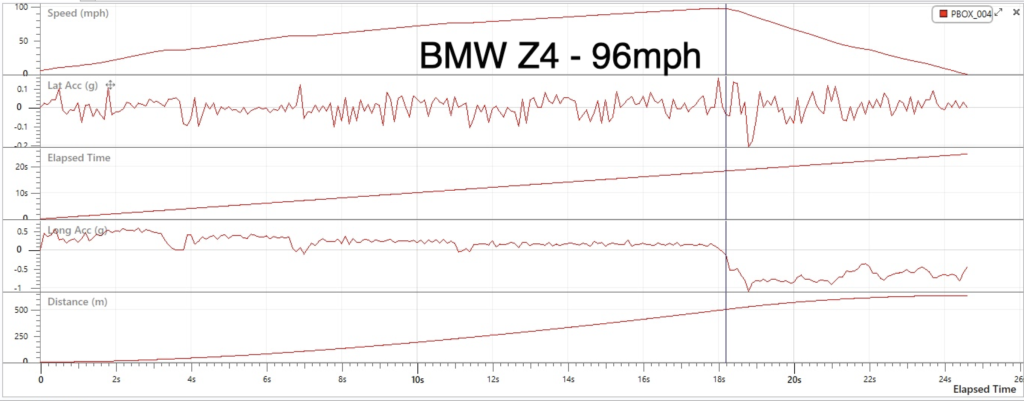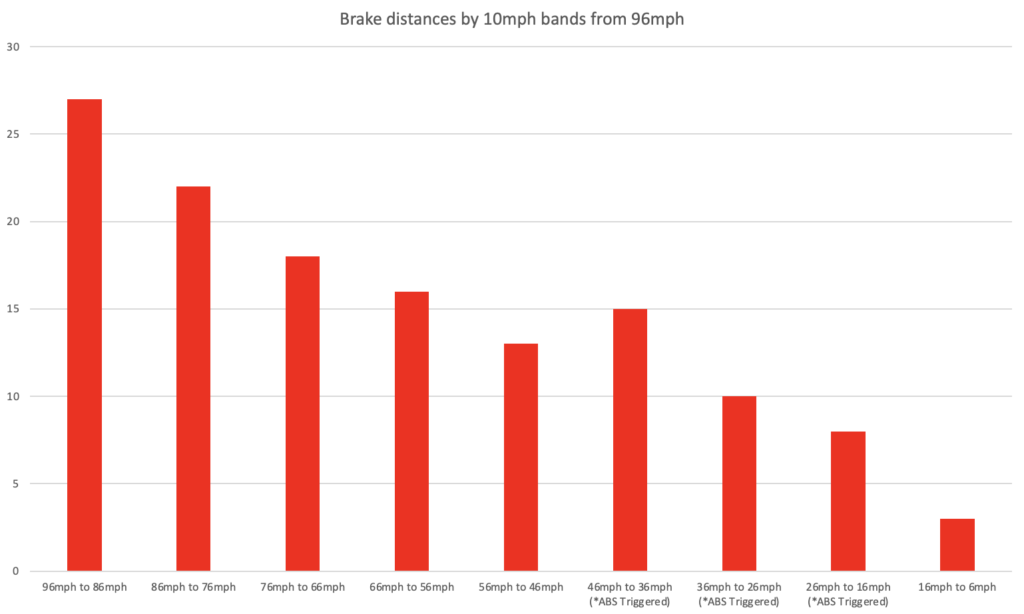A vehicle we use for tests and specialist training is our BMW Z4 3.0L. With 230hp and RWD, it’s well suited for training clients in high-performance training on track, with a specific focus on controlling skids and gaining experience in RWD (Rear Wheel Drive) cars, where power oversteer can catch drivers out.
We do a lot of client driver training at Millbrook Proving Ground. While our training vehicle is not as fast as many cars out there, with 230hp and weighing a little more than 1300kg, it provides a reasonable level of performance – and certainly enough to catch drivers out if they are not aware!
Braking distances are something we like to focus on when training clients. While on a test session at Millbrook, we decided to do some high-speed brake tests, to give some real-world insight into the time and distances involved when you need to emergency brake.
The braking session we did perfectly recreated typical UK driving conditions, as it was cold and the tarmac very damp. We decided to run a number of brake tests, but one we wanted to look at was dealing with an emergency occurring just below 100mph. A speed, which we often see on UK roads, despite of course it being illegal.
Below is data analysis from the specific braking session.

There are quite a few variables we measure on our VBOX performance software as you can see above. The main things we are interested in however are the braking distances and braking time.
At 96mph it took a reasonably high-performance car with excellent brakes and tyres 129 meters to stop (not including reaction times). Bearing in mind this was on a very damp tarmac surface with ABS pulsating away as the car reached lower speeds and a competent and experienced test driver.
It took 6.26 seconds to go from 96mph to zero.
So. Real-World Problems:
While drivers are rarely going to need to emergency brake from a high speed to a standstill on a motorway – although it certainly does happen. What’s more of an issue with driving well above the speed limit is if someone in front of you, not realising how fast you’re travelling, decides to pull out into the lane you’re travelling in. If you’re travelling at 96mph and someone doing 70mph in front of you enters the lane you’re in, based on our training vehicle data, it will take 61 metres for you to polish off your excessive speed to match their speed.
At 96mph you’re travelling at 42.91 meters a second
At 70mph you’re travelling at 31.29 meters a second
In just two seconds the vehicle at 96mph will have closed in some 23.24 metres on the vehicle in front travelling at 70mph. Two seconds may seem fine for most drivers to react, but there are other elements which can make things go very badly wrong, such as:
1. What if the driver doing 70mph pulls out at extremely short notice?
2. What if you’re checking your phone the moment the slow driver pulls out
3. What if you’re tired?
These are interesting points to consider.
The graph below is a breakdown of the 96mph brake test we did at Millbrook. It shows the distance it takes, in 10mph increments, to slow down. Note that from 46mph to 16mph the ABS was triggered, mostly down to the very damp conditions and subsequent lack of tyre grip available. As a result, at these speeds, the braking distances increased a little. ABS is a great invention, which helps a driver remain in control under emergency braking, but as a general rule ABS does not stop you any quicker – in fact in many circumstances it will increase your overall distance. Here is a perfect example.

What did this brake test show?
This very simple test gave an insight into distances involved when driving at different speeds. We are not in the business of preaching road safety, but instead, provide insight to hopefully make drivers have a better knowledge of their driving environment.
Stay tuned for more tests and insights…

